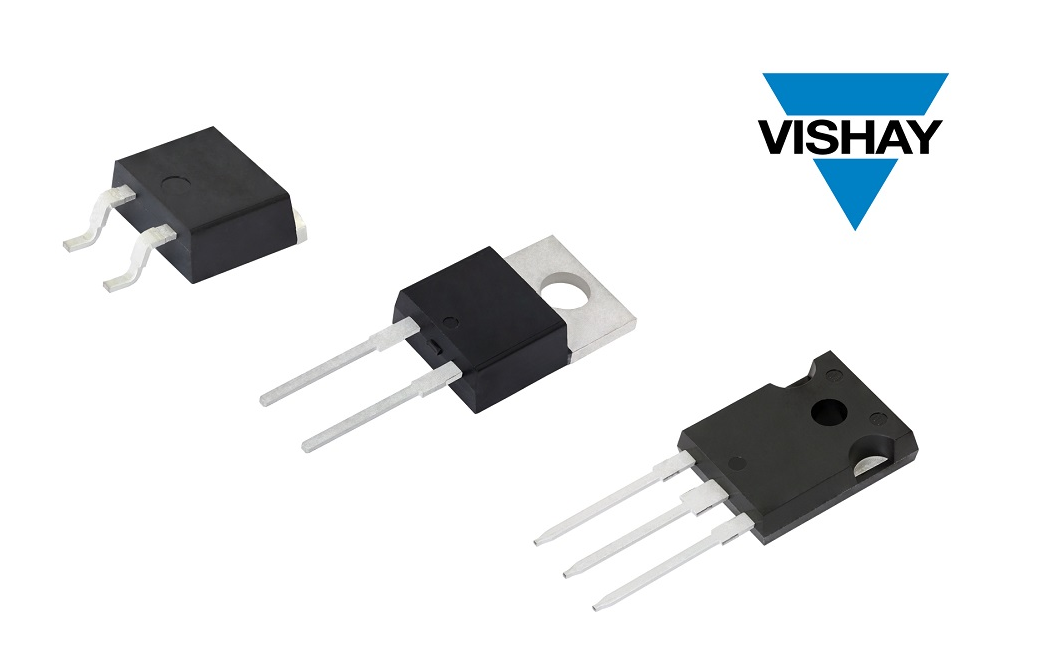
News
Vishay launched the new third -generation 650 V SIC Siteki diode to improve the energy efficiency and reliability of the switching power supply design
A few days ago, Vishay Intertechnology, Inc. (NYSE Stock Market code: VSH) announced that 17 new third -generation 650 VS silicon carbide (SIC) Sterkki diode was launched.Vishay Semiconductors device adopts a mixed PIN SCHOTTKY (MPS) structure design. It has high waves of current protection capabilities. Positive voltage drops, capacitance charges, and low reverse leakage currents will help improve the energy efficiency and reliability of switching power supply.
The new generation SIC diode released a few days ago includes 4A to 40A devices, and the TO-22OAC 2L and TO-247AD 3L plug-in packaging and D2PAK 2L (to-263AB 2L) surface are installed and packaged.Because the MPS structure is adopted, the forward voltage drop is 0.3V lower than the previous generation solution, and the forward voltage drop and capacitor charge product, that is, the important value coefficient (FOM) of the power energy efficiency (FOM), decreased by 17%compared to the previous generation solution.

Compared with close competitive solutions, the typical reverse leakage current at room temperature is 30%lower and 70%lower at high temperature.As a result, the pass loss is reduced to ensure the high energy effects of the system light and empty load.Unlike ultra -fast recovery diode, the third -generation device has almost no recovery of the tail, which can further improve efficiency.
Compared with the penetrating voltage, the SIC diode is high, with low heat guidance rate, low reverse current, and short reverse recovery time.The reverse recovery time of the diodes is almost not affected by temperature changes. It can work at a high temperature of +175 ° C, which will not cause energy efficiency changes due to switching loss.
Typical applications of devices include the AC/DC power factor correction (PFC) and DC/DC ultra -frequency output rectification in the field of power generation and exploration applications.The device has high reliability, which meets ROHS standards, without halogen. It passes 2000 hours of high-temperature anti-bias (HTRB) test and 2000 thermal circulation temperature cycle test. Test time and cycle times are twice as required by AEC-Q101.
|
Product number |
If (av) (a) |
Ifsm (a) |
Under VF (v) under VF (v) |
QC (NC) |
Configuration |
Encapsulate |
|
VS-3C04ET07S2L-M3 |
4 |
29 |
1.5 |
12 |
one |
D2PAK 2L |
|
VS-3C06ET07S2L-M3 |
6 |
42 |
1.5 |
17 |
one |
D2PAK 2L |
|
VS-3C08ET07S2L-M3 |
8 |
54 |
1.5 |
twenty two |
one |
D2PAK 2L |
|
VS-3C10ET07S2L-M3 |
10 |
60 |
1.46 |
29 |
one |
D2PAK 2L |
|
VS-3C12ET07S2L-M3 |
12 |
83 |
1.5 |
34 |
one |
D2PAK 2L |
|
VS-3C16ET07S2L-M3 |
16 |
104 |
1.5 |
44 |
one |
D2PAK 2L |
|
VS-3C20ET07S2L-M3 |
20 |
110 |
1.5 |
53 |
one |
D2PAK 2L |
|
VS-3C04ET07T-M3 |
4 |
29 |
1.5 |
12 |
one |
To-220AC 2L |
|
VS-3C06ET07T-M3 |
6 |
42 |
1.5 |
17 |
one |
To-220AC 2L |
|
VS-3C08ET07T-M3 |
8 |
54 |
1.5 |
twenty two |
one |
To-220AC 2L |
|
Vs-3C10ET07T-M3 |
10 |
60 |
1.46 |
29 |
one |
To-220AC 2L |
|
VS-3C12ET07T-M3 |
12 |
83 |
1.5 |
34 |
one |
To-220AC 2L |
|
VS-3C16ET07T-M3 |
16 |
104 |
1.5 |
44 |
one |
To-220AC 2L |
|
VS-3C20ET07T-M3 |
20 |
110 |
1.5 |
53 |
one |
To-220AC 2L |
|
VS-3C16CP07L-M3 |
2 x 8 |
54 |
1.5 |
twenty two |
Cathode |
To-247ad 3L |
|
Vs-3C20CP07L-M3 |
2 x 10 |
60 |
1.46 |
29 |
Cathode |
To-247ad 3L |
|
VS-3C40CP07L-M3 |
2 x 20 |
110 |
1.5 |
53 |
Cathode |
To-247ad 3L |
The new SIC diode can now provide samples and have been mass -produced, and the supply cycle is eight weeks.